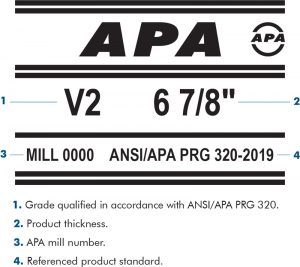A Guide to Selection and Specification
Cross-laminated timber (CLT) is a prefabricated, solid engineered mass timber panel. Because CLT is prefabricated, most components arrive ready to assemble and go together very quickly. CLT’s large-scale components enable faster construction, not only because of prefabrication but because fewer joints are needed between elements.

CLT also offers incredible strength. The crosswise arrangement of board layers lends integral structural stability to the panel, considerably increases dimensional stability, and ensures uniform load transfer to all sides for excellent structural capacities.
CLT’s panel size varies by manufacturer, but typical widths are 2, 4, 8, and 10 feet, with a thickness of 20 inches or less and a length of up to 60 feet. When selecting and specifying CLT, there are several key characteristics to consider, including allowable design capacities, grades, laminations, and adhesives.
Allowable Design Capacities
There are five basic “E” grades, six “V” grades, and three “S” grades for CLT products and layups. E, V, and S indicate a CLT grade with a layup of E-rated or machine stress rated (MSR) laminations, visually graded laminations, or structural composite lumber (SCL) in the longitudinal layers, respectively. Visually graded or SCL laminations are used in the transverse layers for both E and V grades and S grades, respectively. Custom layups of CLT are also permitted, as stipulated in ANSI/APA PRG 320, Standard for Performance-Rated Cross-Laminated Timber.
The allowable stress design (ASD) methodologies reference design capacities for CLT grades with layups of three, five, and seven layers are shown in ANSI/APA PRG 320. The ASD reference design capacities for different CLT products, including custom grades and layups, are typically published in APA Product Reports (www.apawood.org/product-reports) or manufacturers’ literature.
Trademarks and Acceptance
Chapter 10 of the 2018 National Design Specification® (NDS) provides design procedures, reference design values, and other information for CLT, while engineering design of connections using dowel-type fasteners in CLT is covered in Chapter 12 of the 2018 NDS. Sections were also added to the 2021 and 2018 International Building Code and International Residential Code regarding CLT used as different structural elements. Clause 8 in the Canadian Standards Association’s CSA O86-19 provides design procedures, resistance values, and other information for CLT used in Canada. Note: National Design Specification® is a registered trademark of the American Wood Council.
Laminations
Any softwood lumber species or species combinations recognized by the American Lumber Standards Committee under PS 20 or Canadian Lumber Standards Accreditation Board under CSA O141 with a minimum published specific gravity of 0.35 are permitted for use in CLT, provided that other requirements specified in ANSI/APA PRG 320 are satisfied. SCL should meet the requirements of ASTM D5456, Standard Specification for Evaluation of Structural Composite Lumber Products, and have an “equivalent specific gravity” of 0.35 or higher.
Lumber grades must be at least 1200f-1.2E MSR or visually graded No. 2 in the longitudinal layers and visually graded No. 3 in the transverse layers.
Moisture content is required to be 12 ± 3% for lumber and 8 ± 3% for SCL at the time of CLT manufacturing unless a lower moisture content is specifically qualified in accordance with the standard.
Adhesives
In the U.S., adhesives used for CLT manufacturing are required to meet ANSI 405, Standard for Adhesives for Use in Structural Glued Laminated Timber, with the exception that some gluebond durability tests are not required. This is because CLT manufactured according to ANSI/APA PRG 320 is limited to dry service conditions, and some gluebond durability tests are designed for adhesives in exterior applications. In Canada, CLT adhesives must meet the requirements of CSA O112.10. In both the U.S. and Canada, CLT adhesives must meet ASTM D7247 for heat durability and CSA O177, a small-scale flame test. In addition, CLT adhesives must comply with the requirements for elevated temperature performance in accordance with the full-scale compartment fire test specified in Annex B of ANSI/APA PRG 320.

General
CLT shall be furnished and installed following the recommendations provided by the CLT manufacturer and the engineering drawing approved by the engineer of record. Permissible details shall be in accordance with the engineering drawing.
Manufacture
- Materials, Manufacture, and Quality Assurance – Product quality shall conform to ANSI/APA PRG 320, Standard for Performance-Rated Cross-Laminated Timber.
- Trademarks – CLT products conforming to ANSI/APA PRG 320, Standard for Performance Rated Cross-Laminated Timber, shall be marked with CLT grade, CLT thickness or identification, mill name or identification number, the certification agency logo, and “ANSI PRG 320.” The top face of custom CLT panels with unbalanced layup used for roof or floor shall be marked with a “TOP” stamp.
- Protection for Shipment – Members shall be protected with a water-resistant covering for shipment.
Find more information on the selection and specification of structural engineered wood products in the APA Engineered Wood Construction Guide, available as a free download at www.apawood.org.■
This article, all or in part, has been previously published in the APA Engineered Wood Construction Guide, Form E30, December 2019. It is reprinted with permission.
